Characteristics of the Australian pig market: maintaining global competitiveness and industry sustainability
Published: November 20, 2006
By: ROBERT J. VAN BARNEVELD - Alltech Inc.
The role of the Australian pig industry in the global market place has changed significantly in the past five years from virtually no pork exports in 1996 to an export industry worth in excess of $AUD240 million in 2001. As a consequence, the Australian pig industry focus to maintain global competitiveness and long term viability has also changed. The industry has moved from monitoring the cost of production of major exporting nations in an attempt to remain competitive in the domestic market, to implementing strategies to maintain niche export markets based on differentiated Australian pork. Key challenges exist in the areas of feed grain supply and utilisation, maintenance of a clean/green image and production of an export standard carcass.
An outline of the characteristics of the Australian pig market, the path to development of new export markets, factors influencing the competitiveness of the Australian pig industry and strategies for maintaining and increasing competitiveness of the Australian pig industry in a global market place form the basis of this paper.
Snapshot of the Australian pig market
Until recently, the Australian pig industry has focused on domestic supply, and with a per capita consumption of only 20 kg per annum (Meo and Cleary, 2000) has been a small producer by international standards (Table 1) with only 305,000 sows across 2,500 herds in 2001 (Figure 1). The small size of the domestic market, and the fact that the Australian industry is reliant on domestic feed grain supplies made it difficult for Australian producers to compete against leading European and North American export countries. This became evident in 1990 when the federal government opened the Australian markets to imports; and since that time, there has been a progressive relaxation and re-assessment of pig meat import protocols (AFFA, 2001a). By 1998, Australian domestic pork prices had collapsed amidst low world prices and rising imports. At the same time, prospects for the development of an Australian pork export market also appeared very poor. This was due to a lack of differentiation of Australian pork products and the fact that it is difficult for exports to coexist with imports of the same product (Watson, 1999). As a consequence, Australian exports up until 1997 represented only about 1% of farmed production with about 40% of the product leaving Australia being feral pig meat (Ronan et al., 2001). During this time, the four major export clients were Germany, New Zealand, Russia and France with the Russian trade being primarily low-grade, frozen product averaging $AUD2 per kg.
Table 1. Comparative production of pig meat in the Asia Pacific region in 2000 (Australian Pork Ltd, 2002).

Figure 1. Change in the Australian pig industry structure between 1996 and 2000 (from Meo and Cleary, 2000 and Australian Pork Ltd, 2002).
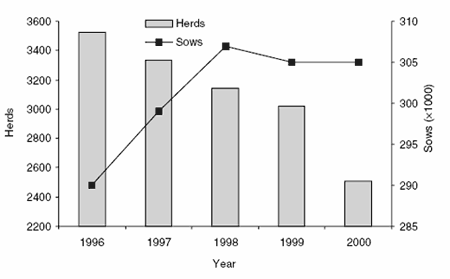
Despite the many factors set against the development of an Australian pork export market, export growth has been exponential since mid-1997 (Figure 2). The development of this market has largely been opportunistic, but the Australian industry has had to be astute to capitalise on its good fortune. The first opportunity arose following an outbreak of foot and mouth disease in Taiwan, which had previously been the world’s third major pork producer, supplying 70% of the Japanese import market (Ronan et al., 2001). Spread of the disease to South Korea, another major exporter to Japan, allowed Australia’s market share in Japan to rise to the current level of about 8,500 tonnes per annum (Jamieson, 2001). While this represents a meteoric rise for the Australian export market, its still represents only 1% of the total Japanese pork imports, so there is still significant room for expansion (Jamieson, 2001; Austrade, 2001).
Figure 2. Import and export quantities (shipped weight ×1000 tonnes) and value ($AUD million) of Australian pig meat between 1996 and 2001 (Australian Pork Ltd, 2002).
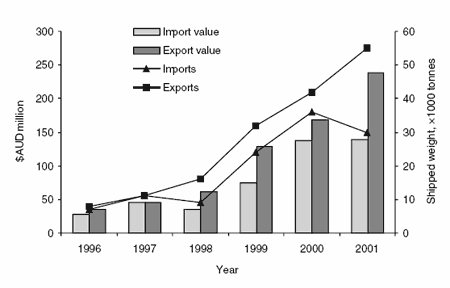
The second opportunity for the Australian export market arose following the outbreak of the ‘Nipah’ virus in the largely Chinese-operated piggeries on the Malay Peninsula. Singapore had been receiving approximately 3000 live pigs per day from Malaysia, but the emergence of the Nipah virus immediately terminated the trade. An existing relationship between the Singaporean government and the Australian Pig Research and Development Corporation allowed Australia to assume a significant trade relationship as soon as the Malaysian industry collapsed; and Australia now supplies about two thirds of its total monthly exports of around 3,000 tonnes to Singapore (Ronan et al., 2001).
A key factor behind the rapid development of an Australian pork export market has been the differentiation of the Australian product. Jamieson (2001) defined the primary attributes of Australian pork in the Japanese and Singaporean markets as being:
1. ‘Clean and green’ image;
2. Consumer appeal of pork with bright meat and snow-white fat;
3. Quality and flavour similar to locally-produced pork;
4. Non-genetically modified feeds – particularly primary feed grains such as wheat and barley;
5. Strict hygiene and safety systems;
6. No hormonal or antibiotic residues;
7. High health status of the Australian herd and the absence of specific disease in Australia (such as foot and mouth disease).
Primary limitations to the expansion of the Australian export market to Japan and Singapore include an inability to provide large volumes of consistent product in the same way as the North Americans and the Danes, an insufficient degree of processing integration and a Japanese preference for pork with a higher level of intramuscular fat than current Australian genotypes and diets produce (Ronan et al., 2001).
The competitive advantage conferred by differentiating Australian pork on the basis of freshness, price, clean/green image, quality, biosafety and quality assurance relative to its major competitors was summarised by Ronan et al. (2001) (Table 2).
The development of the Australian export markets since mid-1997 has had a profound effect on domestic pig prices. In 2002, we have almost reached the situation where domestic demand exceeds available supply; and since June 1998, the price of pig meat has risen from around $1.75 per kg to an average of $2.40 per kg; however, prices have exceeded $2.90 per kg.
Table 2. Competitor comparison of attributes in the supply of chilled pork to Singapore.
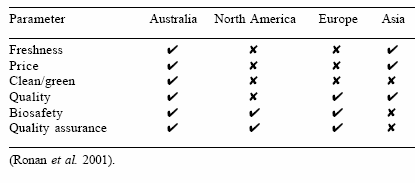
Factors influencing the global competitiveness of the Australian pig industry
In addition to the specific attributes used to differentiate Australian pork in the Asian market place, several other factors influence the competitiveness of Australian pork exports in Asia. Campbell (2001) defined the following as strengths of the Australian pig industry:
• Proximity to Asia;
• The low value of the Australian dollar;
• Climate in pig producing regions;
• The investment in research and development (return on investment in research and development in the Australian pig industry was recently shown to be in the order of 8:1 (AFFA, 2001b)), and;
• The degree of industry integration.
In addition, Campbell (2001) identified many of the weaknesses associated with the Australian pig industry by comparing key performance indicators with a dominant exporting nation such as the United States (Table 3). This reveals that herd feed conversion ratio, sale live weight and the number of pigs sold per sow per year are key contributors to a higher cost of production in Australia. Other weaknesses in the Australian pig industry include:
• The small population size in Australia;
• High grain prices;
• The high cost of labour;
• Inefficiencies in the processing sector, and;
• Production of entire males.
In addition to the strengths and weaknesses identified by Campbell (2001), factors specific to the Asia Pacific region contribute to the competitiveness of the Australian pig industry in the global market. These include regional competitors, compound feed production capacity, demand for limited stockfeed resources, trade restrictions and the economic slowdown in Asia.
REGIONAL COMPETITORS
Now that Australia has developed a niche export market, the need to remain competitive is greater than in other countries with similar production levels in other regions of the world (i.e. Europe, North and South America), with the same holding true for other countries in the region such as Japan, the Philippines, Korea and Taiwan. The main reason for this pressure is the overwhelming dominance of production from China in the Asian region – more than 85% of total pig production in Asia in 2000 (Table 1). Being in the same region, there is competition for similar markets and feed resources; and relative industry size and economies of scale are likely to influence competitiveness. China is also one of the few Asian countries showing signs of economic growth.
Table 3. Comparison of key pig industry performance indicators in Australia and the United States in 2000.
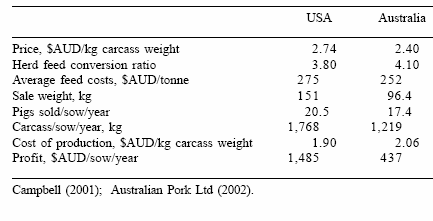
COMPOUND FEED PRODUCTION CAPACITY
Severe economic conditions in the Asia Pacific region have caused a significant contraction in compound feed production in recent years (Gill, 1999). For example, the foot and mouth disease outbreak in Taiwan resulted in a 20% output reduction, but in some countries the decrease has been as much as 40% with no disease influences. Economies of scale in Australian compound feed production relative to the size of the pig industry (recognising the use of the bulk of compound stockfeeds by other livestock industries) is likely to have a positive influence on production efficiency.
DEMAND FOR LIMITED STOCKFEED RESOURCES
Increased demand for limited feed grain resources has a significant influence on the ability of pig producers to remain competitive in Australasia. For this reason, those producers able to efficiently utilise feed resources have the greatest chance of remaining viable. The Australian pig industry is currently self-sufficient in terms of grain supply, and must remain so given tough import restrictions for whole grains in an attempt to keep specific diseases out of the country. Existing and emerging export commitments for Australian grains can limit the amount of grain available for livestock production, as can drought, both important considerations for an expanding pig industry.
WORLD TRADE ORGANIZATION TARIFF REDUCTIONS
The implementation of the 1995 World Trade Organisation (WTO) agreement will mean that tariffs for pork in Asian countries, with the exception of Japan, will decline by 30 to 60% during the agreement’s phase-in period, which continues until 2004 (Table 4). This will provide significantly more market access than exporting nations have enjoyed in the past (Martin et al., 1998).
ECONOMIC SLOWDOWN
Demand for products such as pork in Asia is fragile. Japan remains in recession and will be slow to emerge. Other parts of Asia such as Singapore and Taiwan are slowing rapidly; and Thailand, Malaysia and Korea have not made the reforms necessary to recover from the Asian currency crisis (Oxley, 2001). Importantly, the low value of the Australian dollar has held up Australian exports to Asian countries such as Japan because while they are significantly cheaper than the domestic product, the demand for the product can grow while the overall demand in the economy falls (Oxley, 2001).
Table 4. Changes in committed tariff equivalents for pork.
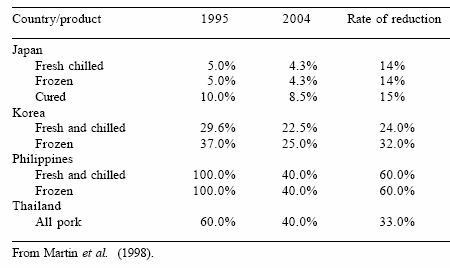
Maintaining and increasing competitiveness and industry sustainability
Based on the attributes differentiating Australian pork and the factors influencing the global competitiveness of the Australian pig industry, we are able to identify a number of key areas that the industry can address to maintain and increase competitiveness and long-term viability. Some of these include feed grain supply and utilisation, and niche markets: production of export-standard carcasses and maintenance of a ‘clean/green’ image.
FEED GRAIN SUPPLY AND UTILISATION
Improving feed grain supply
The issue for Australia in terms of feed grain supply has more to do with price than quantity available. In years of drought when downgraded crop is scarce, the grain exists but it is not available at a price that is sustainable for the pig industry. The ratio of pig:grain prices in Australia is highly variable; and when feed grain prices are consistently high, the viability of the industry becomes highly dependent on pork prices (Figure 3). Volatility in feed grain supply will remain in Australia until the supply of dedicated feed grains improves. Unless there is a cost advantage, a price premium or a yield advantage of a feed grain over a human food grain, there is no incentive for grain producers to aim to produce feed rather than food grains (Taverner, 2001). In the longer term, development of dedicated feed grain varieties will assist the pig industry to grow, to ensure a consistent supply of quality product to export markets and to remain viable. In the short term, a focus on feed grain utilisation will assist industry competitiveness and viability. Development of grains that contain increased levels of specific nutrients have only marginal benefit for the pig industry; however elimination of specific antinutritional compounds in some ingredients warrants further investigation.
Figure 3. Ratio of pig price to grain price in Australia between 1996 and 2001 (from Australian Pork Ltd, 2002).

Improving feed grain utilisation
Feed grain utilisation can be improved by increasing the yield of nutrients from existing resources, by improving the definition of nutritional quality prior to incorporation into pig diets and by minimising the potential for physical, chemical or microbiological contamination of the grain. Fundamental to achieving the former two is an understanding of those factors that influence nutritional quality, particularly available energy content. To date, attempts to identify the primary chemical components responsible for variation in the available energy content of grains for pigs have not progressed significantly beyond broad definitions of fibre components. This could be due to the fact that digestible energy (DE) is the chosen measure of available energy. Application of DE as a measure of available energy for pigs can be shown to be highly insensitive, and as a consequence only those parameters that have a major influence on hindgut fermentation in the pig will have a significant influence on DE. When more sensitive measures of nutritional quality are applied, the influence of gross fibre characteristics on the nutritional quality of the grain becomes less pronounced. For example, van Barneveld et al. (2001) demonstrated that ileal energy digestibility can be correlated with specific non-starch polysaccharide components such as arabinoxylose (Table 5).
Table 5. Stepwise regression analysis of the chemical and physical composition of 11 barley cultivars against pig diet ileal digestible energy content.
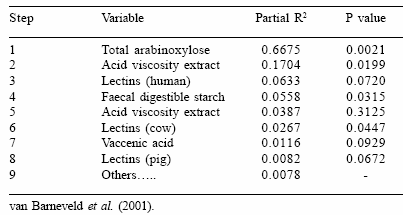
With the above in mind, it appears that a better understanding of the factors that influence the available energy supply from grains fed to pigs may be achieved by examining a more sensitive measure of available energy, such as ileal digestible energy, in addition to DE. An increased focus on digestion of energy in the small intestine is also likely to result in improved responses in pigs to the application of
exogenous enzymes.
Near infrared spectroscopy (NIRS) offers the best opportunity for rapid prediction of grain nutritional quality prior to incorporation into pig diets. Van Barneveld et al. (1999) developed an NIRS calibration for the measurement of DE in cereals for growing pigs. It was concluded from this research that DE in whole grain cereals can be measured by NIRS to an accuracy of 0.38 MJ/kg (Table 6), which is comparable to the accuracy obtained when using in vivo reference methods.
No significant differences in accuracy were observed between milled grain and whole grain calibrations or between local and global calibrations.
Table 6. Summary of calibration statistics for digestible energy (MJ/kg) in whole and milled cereal grains for pigs.
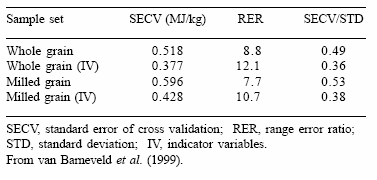
Utilization of mycotoxin-contaminated grains
Contamination of grains is a key issue for Australian producers. Chemical contamination is of primary concern for export markets, however, the risk of residues arising from chemical contamination of grains is very small (BECAN, 1999). Of more concern is the negative production arising from grain contamination with moulds and mycotoxins. While rapid and objective analytical tests for moulds and mycotoxins may be useful tools, BECAN (1999) suggest they may only play a minor role in dealing with contaminated grain and the focus should be on the amelioration of contaminated grains. The reasons for this include:
1. In many cases, the symptoms associated with mycotoxicosis are described in relation to a single mycotoxin. It has been clearly demonstrated, however, that synergism exists between some mycotoxins and that there is a possibility that a number of masked, unidentified mycotoxins may be influencing livestock production in some instances. A major complication when dealing with acceptable levels of mycotoxin contamination is the fact that mycotoxins in combination appear to exert greater damage to health and productivity in comparison to their individual effects.
2. Tolerances to mycotoxins determined experimentally may be of limited use. This is because tolerances obtained experimentally usually employ relatively small numbers of animals fed well balanced diets, while in the field there can be great variation in individual susceptibility, confounded by stressors not present under experimental conditions. In addition, the many studies that have been conducted to assess animal responses to grain contamination are likely to be highly specific to the mode of contamination of that one test sample.
Rather than identifying samples of grains that pose the greatest risk of being contaminated, analysing the samples for specific mycotoxins, and then either rejecting, diluting or redirecting the grain, BECAN
(1999) suggested that a more practical approach would be to:
1. Identify those grains that could potentially be contaminated with moulds and/or mycotoxins, or those grains with the greatest potential to develop mould infestations during storage;
2. Apply a mould inhibitor or mycotoxin binder where appropriate;
3. Utilise mycotoxin binders for deactivation of any mycotoxin that may be present based on rapid test results.
4. Compensate for any reduction in the nutritional value of the grain resulting from mould infestation.
The advantages of this approach are to eliminate the need for quantitative analysis (i.e. a positive result justifies application of an ameliorant), no load of grain will be rejected and there will be no subclinical reductions in animal performance or overall health through feeding grain with low levels of contamination (BECAN, 1999).
PRODUCTION OF AN EXPORT STANDARD CARCASS
Increased level of intramuscular fat and improved fat quality
As well as being preferred by the Japanese market, higher levels of intramuscular fat or marbling in pork have been shown to positively influence its juiciness, tenderness and flavour (Wood, 1993). Fast growing ‘white’ European breeds such as Large White, Landrace and Yorkshire have lower levels of marbling compared with darker skinned breeds such as Duroc and Berkshire. Hence, utilisation of F1 x Duroc pigs should be a focus for Australian producers targeting the Japanese and Singapore markets (Austrade, 2001).
Fat quality is another area that can be influenced by the producer. D’Souza and Mullan (2001) suggested that restricting the level of dietary unsaturated fats can reduce the incidence of soft fat, and restricting the use of dietary fish oils to 0.5% for at least two weeks prior to slaughter will maintain the processing and keeping qualities of the pork.
Castration
Increasing slaughter weights in Australia will require significant cooperation between producers and processors and involves many factors that will not be discussed here. However, further increase in pig slaughter weights in Australia will be limited by the continued use of boars rather than barrows since growth rate, feed conversion efficiency and product quality decline rapidly at heavier weights (Campbell, 2001). Australia has a technical advantage in the form of immunocastration using products such as Improvac, which enables most of the efficiency advantages offered by boars to be exploited without the behaviourally-related decline in performance during late development.
Focus on pork quality and freshness
D’Souza and Mullan (2001) identified a range of feeding strategies that can be employed to improve the eating quality and presentation of pork through enhancement and maintenance of colour and juiciness and reduction in drip loss. These included:
• Use of feed additives such as vitamin E, selenium and magnesium;
• Use of metabolic modifiers such as porcine somatotropin, chromium, betaine, conjugated linoleic acid and ractopamine.
MAINTENANCE OF A CLEAN/GREEN IMAGE
Non-GMO feed certification
Pursuing a non-GMO feed certification strategy for the development of export markets is not sustainable for the Australian industry. It is already difficult to eliminate GM ingredients given the reliance on vitamin and mineral premixes and synthetic amino acids in pig diets; and exclusion of mammalian proteins will increase the reliance on products such as soybean and canola meal that have well established GM lines in commercial production.
Further to this, use of GM feed ingredients is not a food safety or health issue. Australian food authorities (ANZFA) have stated that there are no food safety concerns associated with the direct food use of Australia’s current GMOs (Taverner, 2001). It has also been reported that the Canadian food authorities, who have approved about 48 GM food ingredients, are yet to find a food safety issue. All reports on GM feedstuffs suggest that there is no difference between animals raised on feeds with GM ingredients and those raised on non-GM feeds.
However, debate on GM technology in Europe and parts of Asia has included whether GM feed ingredients should be included in animal diets. While it is important to respond to the perceptions and needs of the buyers and consumers, we have to be realistic about the practicalities of conforming given the existing widespread occurrence of GMO ingredients and difficulties associated with differentiating between GM and non-GM ingredients. Maintenance and expansion of existing export markets by the Australian pig industry based on non-GMO feed certification requires careful consideration.
Mammalian-protein free diets
Outbreaks of BSE in parts of Asia have increased the awareness of what we feed our pigs. Use of animal protein meals in pig diets has come under increasing scrutiny, and it is likely that export markets will soon ask for their exclusion (if they have not already done so). This is likely to have varying effects on the profitability of the Australian pig industry depending on prevailing pig prices and the price of alternative protein sources. One strategy that will help contain the cost of pig diets is the use of exogenous enzymes and upgrading the available energy and amino acid content of specific feed ingredients (by between 1.5 and 2.5%) at the time of formulation. This approach can limit the impact of animal protein meal exclusion providing sufficient alternative protein sources are available.
Conclusions
Australia has entered the global marketplace with rapid growth in exports to Asian countries such as Japan and Singapore in the last five years. Australian pork is differentiated on the basis of freshness, price, clean/green image, quality, biosafety and quality assurance. Major challenges facing the Australian industry include improving global competitiveness through improvements in herd feed conversion efficiency, slaughter weights and the number of pigs sold per sow per year. A number of strategic approaches need to be adopted by the Australian pig industry to maintain their place in the global market place including improving feed grain supply and utilisation, producing export standard carcasses and maintaining the clean/green image.
References
Agriculture, Fisheries and Forestry Australia (AFFA). 2001a. Generic import risk analysis (IRA) for uncooked pig meat. Issues paper. AFFA: Canberra, ACT.
Agriculture, Fisheries and Forestry Australia (AFFA). 2001b. Innovating Rural Australia – Research and Development Outcomes. AFFA: Canberra, ACT.
Austrade. 2001. Ministerial briefing notes – Pig industry delegation to Japan, Taiwan and Singapore. June, 2001. Austrade: Canberra, ACT.
Australian Pork Ltd. 2002. Pigstats 2000/01. Australian Pork Ltd: Canberra, ACT.
BECAN. 1999. Contaminants in premium livestock grains – preliminary report on chemical residues in premium livestock grains. Grains Research and Development Corporation, Canberra.
Campbell, R.G. 2001. Threats and opportunities for the Australian pork industry – competing in the world arena. Proceedings of the Pan Pacific Pork Expo. Brisbane, Queensland. pp. 25-32
D’Souza, D.N. and B.P. Mullan. 2001. Managing the eating quality of pork – What the producer can do. In: Manipulating Pig Production VIII (P.D. Cranwell, ed.) Australasian Pig Science Association: Werribee. pp. 88-96.
Gill, C. 1999. First, Asian feed slump…now, global stagnation? In: Feed International. January, 1999. Watt Publishing Company, Mt Morris, Illinois, USA. pp. 4-10.
Jamieson, S. 2001. The opportunities and challenges faced in exporting Australian pork to Japan. Proceedings of the Pan Pacific Pork Expo pp. 71-76. PPPE: Brisbane, Queensland.
Martin, L., Z. Kruja and J. Alexiou, J. 1998. Prospects for hog production and processing in Canada. George Morris Centre, Guelph, Ontario.
Meo, H. and G. Cleary. 2000. Pigstats 99. Australian Pork Corporation, Sydney, Australia.
Oxley, A. 2001. The global trading environment – strategic influences. Proceedings of the Pan Pacific Pork Expo PPPE: Brisbane, Queensland. pp. 108-112.
Ronan, G., J. Langberg and M. Moore. 2001. Evaluating the export growth strategy of the Australian pork industry. Proceedings of the 45th Annual Conference of the Australian Agricultural and Resource Economics Society – Agricultural Perspectives Paper 43. ISSN 1442-6951.
Taverner, M.R. 2001. Technologies for managing grain issues. Proceedings of the Pan Pacific Pork Expo pp. 45-65. Brisbane, Queensland.
van Barneveld, R.J., J.S. Nuttall, P.C. Flinn and B.C. Osborne. 1999. NIR reflectance measurement of the digestible energy content of cereals for growing pigs. Journal of Near Infrared Spectroscopy 7:1-7.
van Barneveld, R.J., Y.J. Ru, R.J. Hughes, P.C. Flinn and J.L. Black. 2001. Comparative digestion of energy from grains fed to pigs, poultry and ruminants: can the efficiency of pig production be improved? In: Manipulating Pig Production VIII. (P.D. Cranwell, ed.) Australasian Pig Science Association, Werribee. pp. 222-234.
Watson, A. 1999. Pigs! Agenda. 6(2).
Wood, J.D. 1993. Production and processing practices to meet consumer needs. In: Manipulating Pig Production IV. (E.S. Batterham, ed.). (Australasian Pig Science Association: Werribee). pp. 135-147.
Author: ROBERT J. VAN BARNEVELD
Barneveld Nutrition Pty Ltd and the BECAN Consulting Group, South Maclean, Queensland, Australia
Related topics
Join to be able to comment.
Once you join Engormix, you will be able to participate in all content and forums.
* Required information
Would you like to discuss another topic? Create a new post to engage with experts in the community.
Create a post




.jpg&w=3840&q=75)